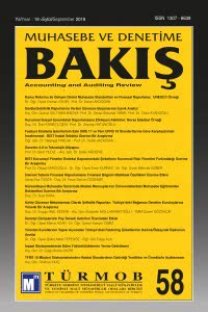İŞLETMELERDE SİBER RİSKLERİN ANALİZİNDE, HARİTALANMASINDA VE DEĞERLENDİRİLMESİNDE İÇ DENETİMİN ROLÜ
Siber Riskler, Analiz Metotları, Risk Haritaları, İç Denetim
THE ROLE OF INTERNAL AUDIT: ANALYSIS, MAPPING AND ASSESSMENT OF CYBER RISKS IN ENTERPRISES
Cyber Risks, Analysis Methods, Risk Maps, Internal Auditing,
___
- Akhtar, Tafseer ve Gupta, B.B., “Towards a Framework for Analyzing Cyber Attacks Impact Against Smart Power Grid on SCADA System”, International Conference on Communication and Signal Processing(ICCSP), 2018, s. 1087-1093.
- Guinta, LR. ve Frantzve, LA., “Critically, Vulnerability, Risk Logic Analysis Methodology for Business Enterprise and Cyber Security”, 2010, s. 983.
- Gusmão, A., Silva, M., Paleto, T., Thiago, P., Silva, L., “Cybersecurity Risk Analysis Model Using Fault Tree Analysis and Fuzzy Decision Theory”, International Journal of Information Management, 2018, Volume 43, Num- ber 6, s. 248.
- Haimes, Y.Y., “On The Definition of Resilience in Systems”, Society For Risk Analysis, 2009, Volume 29, Nuım- ber 4, s. 498-504.
- Kayrak, M., “Bilgi Kriterleri Çerçevesinde Bilişim Teknolojileri Denetimi”, Journal of Turkish Court of Accounts/ Sayıştay Dergisi, Ekim 2012, Cilt 23, Sayı 87 s. 143-167.
- Kurnaz, N. ve Dindaroğlu, A.K., “İç Denetim ve Bilgi Güvenliği İlişkisi: Bölgesel Bir Araştırma”, Bilgi Ekonomi- si ve Yönetimi Dergisi, 2015, Cilt 10, Sayı 1, s. 51-63.
- Kurt, G. ve Uysal, T.U., “Siber Riskler ve COSO İç Kontrol Bütünleşik Çerçevesi”, Muhasebe ve Denetime Bakış, 2015, Cilt 46, Sayı 15, s. 1-10.
- Linkov, I., Eisenberg, D.A., Plourde, K., Seager, T.P., Allen, J., Kott, A.(2013), “Resilience Metrics for Cyber Systems”, Environment Systems and Decisions, 2013, Volume 33, Number 4, s. 471-476.
- Mukhopadhyay, A., Chatterjee, S., Saha, D., Mahanti, A., Sadhukhan, S., “Cyber-risk decision models: To insure IT or not?”, Decision Support Systems, 2013, Volume 56, s. 11-26.
- Öztürk, M.S., “Siber Saldırılar, Siber Güvenlik Denetimleri ve Bütüncül Bir Denetim Modeli Önerisi”, Muhasebe ve Vergi Uygulamaları Dergisi, 2018, s. 208-232
- Ralston, P.A.S. ve Graham, J.H. & Hieb, Jeffrey., “Cyber security risk assessment for SCADA and DCS networks”, ISA transactions, 2007, Volume 46, Number 4, s. 583-594.
- Rot, A., “IT Risk Assessment: Quantitative and Qualitative Approach”, The World Congress on Engineering and Computer Science, 2008.
- Spoonamore, S., “CCLIF: A Quantified Methodology System to Assess Risk of IT Architectures and Cyber Ope- rations”, 2008, s. 716.
- Topaloğlu, S., “Sosyal Güvenlik Suiistimallerinin Tespiti ve Önlenmesi için Risk Analizi ve Sürekli Denetim Yön- temleri”, TISK Akademi, 2013, Cilt 8, Sayı 16, s. 204-219.
- Uludağ, S., “Değişen Risk Algısı ve İç Denetim”, Muhasebe ve Denetime Bakış, 2017, Cilt 17, Sayı 51, s. 93-101. Yılmaz, S. ve Sağıroğlu, Ş., “Siber Güvenlik Risk Analizi, Tehdit ve Hazırlık Seviyeleri”, 6. Uluslararası Bilgi Güvenliği ve Kriptoloji, 2013, s. 158-166.
- ISSN: 1307-6639
- Yayın Aralığı: Yılda 3 Sayı
- Başlangıç: 2000
- Yayıncı: TÜRMOB
SOSYAL MEDYA İLETİŞİMİNDE SOSYAL MEDYA DENETİMİNİN ÖNEMİ
Zeynep BAYAZIT, Ali Altuğ BİÇER
MUHASEBE ARAŞTIRMALARINDA DURUMSALLIK TEORİSİNİN YERİ
İŞLETMELERDE SİBER RİSKLERİN ANALİZİNDE, HARİTALANMASINDA VE DEĞERLENDİRİLMESİNDE İÇ DENETİMİN ROLÜ
Seval KARDEŞ SELİMOĞLU, Mustafa Hakan SALDI
TÜRKİYE DENETİM STANDARTLARINDA ADI GEÇEN DENETİM TÜRLERİNİN GENEL YAPI AÇISINDAN KARŞILAŞTIRILMASI
MUHASEBE MESLEK MENSUBU ADAYLARININ UFRS FARKINDALIĞI
Mehmet Emin KARABAYIR, Seyhan ÖZTÜRK, Emrah ERTUGAY
Derya ÜÇOĞLU, Faruk Ziya FIRAT
“TFRS 15 Müşteri Sözleşmelerinden Hasılat” Çerçevesinde Hasılatın Ölçülmesi ve Raporlanması
Alim Çağdaş ÜNLÜTÜRK, Ece Nur DEVECİ, Muhammet Fatih DAĞLI
FİNANSAL RAPORLAMAYA İLİŞKİN KAVRAMSAL ÇERÇEVE: DEĞİŞİKLİKLER ve KARŞILAŞTIRMALAR
